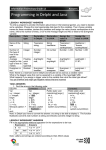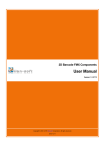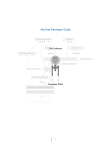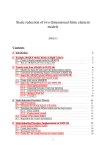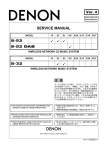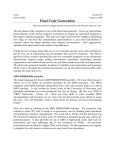Download Tutorial 16 Event Driven Coding
Transcript
maXbox Starter 16
Start with Event Driven Programming
1.1 Set an Event
Today we spend another small time in programming with a new concept called events. Most modern
programming languages (like PHP, Python or Ruby) are dynamically typed, event driven and employ
an interpreter for program execution.
Event driven programming are usually message based languages offering the user an interactive
dialog allowing commands that are interpreted and immediately executed like a button click see below.
We will concentrate for the first on creating an API call of a DLL using PlaySound() from the
winmm.dll library as the result of a asynchronous timer event. But, first of all I'll explain you what
"synchronous" and "asynchronous" events are. In fact there are 2 programming models used in event
driven applications:
•
Synchronous events
•
Asynchronous events
Some event handlers are called immediately when the event occurs, otherwise you have to wait.
These are called ‘synchronous’ events. An example is CloseButtonClick(). It gets called as soon
as the user hits the close button.
However, some events are called or executed after the event occurs, usually after a short amount of
idle time. With these asynchronous events you don’t have to wait, so the caller continues without
pausing for a response!
All the windows and dialog boxes in your application are based on the class TForm.
A VCL form contains the description of the properties of the form and the components it owns. Each
form file or a form code section represents a single form, which usually corresponds to a window or
dialog box in an application and are able to handle events.
Every Delphi application must have or provide a main form. The main form is the first form created in
the body of the application. When the main form closes, the application terminates.
328 procedure CloseButtonClick(Sender: TObject);
329 begin
330
frmMon.Close;
331 end;
So what’s event driven programming?
Event-based programs are organized around the processing of events. When a program cannot
complete an operation immediately because it has to wait for an event (e.g., the arrival of a packet or
the completion of a disk store transfer), it registers a callback; a function that will be invoked when the
event occurs. Event-based programs are typically driven by a loop that polls for events and executes
the appropriate callback when the event occurs.
This is the famous message-loop (waiting for events) in the window model, see below chart2:
while GetMessage(lpMsg,0,0,0) do begin
TranslateMessage(lpMsg);
DispatchMessage(lpMsg);
end;
A callback executes indivisibly until it hits a blocking operation, at which point it registers a new
callback and then returns. So in our close event, how does the callback look like?
onClick:= @CloseButtonClick;
onClose:= @CloseFormClick;
As said above, we register a callback @CloseButtonClick with the address operator, so the
callback function will be executed when the event onClick occurs, in our case the button is clicked!
The interesting point is the separation of event and event handler (callback routine).
An event handler is a callback routine that operates asynchronously and handles inputs received
into a program (events). In this context, an event is some meaningful element of program information
from an underlying development framework, usually from a graphical user interface (GUI) toolkit or
some kind of input routine. On the GUI side, events include key strokes, mouse activity, action
selections, messages or timer expirations. On the input side, events include opening or closing files or
forms and data streams, reading data and so on.
Now we come to the first API event.
Hope you did already work with the Starter 1 to 15 available at:
http://www.softwareschule.ch/maxbox.htm
Remember: What makes the event synchronous or asynchronous is whether it’s handled
synchronously (blocking) or asynchronously (non-blocking.)
Non Blocking means that the application will not be blocked when the application plays a sound or a
socket read/write data. This is efficient, because your application don't have to wait for a sound result
or a connection. Unfortunately, using this technique is little complicated to develop a protocol. If your
protocol has many commands or calls in a sequence, your code will be very unintelligible.
A synchronous event is an event that – when fired - waits on a response from something called an
event handler.
A function which returns no data (has no result value) can always be called asynchronously,
cause we don’t’ have to wait for a result or there’s no need to synchronise the functions.
Let’s begin with the application structure process in general of an API call:
The PlaySound function plays a sound specified by the given file name, resource, or system event.
(A system event may be associated with a sound in the registry or in the WIN.INI file.)
1. Header: Declared in msystem.h; include Windows.h.
2. Library: Use Winmm.dll or the lib.
3. Declaration of the external function
4. Load the DLL and call the API function
•
Static at start time
•
Dynamic at run time
5. Unload the DLL (loaded DLL: C:\WINDOWS\system32\winmm.dll)
So we call the API function dynamic at runtime and of course asynchronously. The sound is played
asynchronously and PlaySound returns immediately after beginning the sound. To terminate an
asynchronously played waveform sound, call PlaySound with pszSound set to NULL.
www.softwareschule.ch
2
The API call to the function just works fine, doesn't have any glitch.
On the other side a sound is played synchronously, and PlaySound returns after the sound event
completes. This is the default behaviour in case you have a list of songs.
If you click on the menu <Debug/Modules Count> you can see all the libraries (modules) loaded by
your app and of course also the winmm.dll with our function PlaySound() in it.
25 function BOOL PlaySound(
LPCTSTR pszSound,
HMODULE hmod,
DWORD fdwSound
);
1: Result as of the loaded Modules
1.2 Code Event handling with an API Call
As you already know the tool is split up into the toolbar across the top, the editor or code part in the
centre and the output window shell like a song length protocol result at the bottom.
Included in the package maXbox is the integrated MP3 Songs utility player as an add-on listed on the
menu /Options/Add Ons/. But we show the tool as a script extract with source, an add-on is a real
compiled and integrated script.
There is a special function in Win32 which plays .wav files. You do not need the full Windows Media
Control Interface. You can either play the sound by mentioning its filename (in which case the file
needs to be distributed with the program) or by making the file into a resource with a line like
PlaySound("SoundName", hInst, SND_RESOURCE | SND_ASYNC);
The following example stops playback of a sound that is playing asynchronously:
PlaySound(NULL, 0, 0);
If you set the flag SND_NOSTOP we get an interesting constellation.
This specified sound event will yield to another sound event that is already playing. If a sound cannot
be played because the resource needed to generate that sound is busy playing another sound, the
function immediately returns FALSE without playing the requested sound.
If this flag is not specified, PlaySound attempts to stop the currently playing sound so that the device
can be used to play the new sound (again).
www.softwareschule.ch
3
Discussion:
I have an app that has a background sound and a sound when someone clicks something. But when
they click the something sound it stops the background sound, which is supposed to loop. How can I
play both sounds and leave the background looping?
Answer:
I'm 99% sure that the PlaySound API (which SoundPlayer.Play is wrapping) does not support this
no matter how you do it. You will have to look at something like DirectX or multithreading if you really
want to do this.
I'm trying to get the SoundPlayer to play two wav files at the same time. The documentation says is
should play asynchronously but when I try, it seems to end the play of the first SoundPlayer as soon
as the second one starts to play.
I read the documentation, and it doesn't imply that it will merge the two sounds, merely that the
method call is asynchronous. Internally PlaySound calls the PlaySound API from mmsystem.h, with
the parameters SND_ASYNC and SND_NODEFAULT. This means so far that "The sound is played
asynchronously and PlaySound returns immediately after beginning the sound..." and "No default
sound event is used. If the sound cannot be found, PlaySound returns silently without playing the
default sound."
Chart 2: Message Driven Events in Windows
In a Win32/64 application, we start a message loop that fetches messages from a queue, translates
them and then dispatches them. Eventually, each message reaches our WndProc where the
associated event can be handled in a case construct.
So the event is the timer which will be answered be the event handler WMTimerBeep and then
executed by the MessageBeep() or PlaySound().
The OS maintains a message or system-queue, where it puts the events (e.g., from interrupts or other
sources). It then sends the messages from that queue to all windows, depending on the message
(e.g., it won't send key messages to a window that doesn't have focus).
www.softwareschule.ch
4
A message is posted to every window that should receive it. The OS decides depending on the type of
message whether a window should receive that message or not.
Most messages are waited for by the system, i.e., the message won't get posted to another window
until it was processed by the window. This has a great impact for broadcast messages: if one window
doesn't return when handling that message, the queue is blocked and other windows won't receive the
message anymore.
So, as far as I can see it implies that the API call queues up the sounds to be played, and the
method returns when your sound starts playing, so there’s no parallel processing possible!
So after this hard low-level introduction we jump to our app, a small form which counts the characters
of a text file and deepen our knowledge with events.
Before this starter code will work you will need to download maXbox from the website. It can be
down-loaded from http://sourceforge.net/projects/maxbox site. Once the download has finished, unzip
the file, making sure that you preserve the folder structure as it is. If you double-click maxbox3.exe
the box opens a default program. Make sure the version is at least 3.8 because Modules Count use
that. Test it with F2 / F9 or press Compile and you should hear a sound and a browser will open. So
far so good now we’ll open the example:
287_eventhandling2.txt (20888 kb)
Or 263_async_sound.txt
If you can’t find the file use one of those links:
http://www.softwareschule.ch/examples/287_eventhandling2.txt
http://www.softwareschule.ch/examples/287_eventhandling2.htm
Or you use the Save Page as… function of your browser1 and load it from examples (or wherever
you stored it). One important thing: The mentioned DLL must reside on your harddisk. Now let’s take a
look at the code of this project first with the declaration of the 2 forms. Our first line is
1 Program EventHandler_Tutorial;
We have to name the program it’s called EventHandler_Tutorial. Next we jump to line 19:
16 var
17
Exc2: Exception;
18
Image1, Image2: TImage;
19
frmMon, frmMon2: TForm;
First in line 19 we ask to set 2 form variables. Forms are important for all IT systems that offer
interfaces for user or programming access. Particularly, this includes machines in the private and
commercial sector as well as services like electronics or multimedia. In these cases the var
declaration is usually done by entering a form name and the according class name.
As we now know, TForm is able to handle the events as a window function. The Windows API
function used to create parent (top-level) and child windows is called CreateWindow.
The event handler method must accept four parameters: hWnd, the handle for the window that
received the message; nMessage, the Windows message number; and two Integer parameters, the
contents of which vary depending on the Windows message (the documentation for each message
describes the values of these parameters).
1.3 Event and Event Handler in a Form
Typically, you create forms for your application from within the IDE with a form designer. In maXbox
we can code directly and native in the script your form with controls. When created this way, the forms
have a runtime constructor that takes one argument, Owner, which is the owner of the form being
created. (The owner is the calling application object or form object.) Owner can be NIL.
1
Or copy & paste
www.softwareschule.ch
5
To pass additional arguments to a form, create a separate constructor and instantiate the form using
this new constructor. The owner of a component is determined by the parameter passed to the
constructor when the component is created. But there are three or four possibilities passing one:
Application, Self, NIL or a Owner by Yourself
3: Our App with x events on a second form
By default, a form owns all components that are on it. In turn, the form is owned by the application.
Thus when the application shuts down and its memory is freed, the memory for all forms (and all their
owned components) is also freed.
Hint: Owner is a property of TComponent so you don't have to declare it when passing to the
Constructor. In our case when dynamically creating one or more components as part of a form, the
owner has to be the form itself, so you refer to the form via the self pointer in line 336 and a reference
pointer by yourself (inFrm).
335 begin
336
frmMon:= TForm.Create(self);
348
Image1:= TImage.create(frmMon);
356
Image2:= TImage.create(frmMon);
Next we step to the concept of event handlers. Once you determine when the event occurs (later in
the main program), you must define how you want the event handled.
Specifying a second event handler object in line 345 or delegate method causes the first binding to be
added with the second, simply means the form can handle 2 events:
337 with frmMon do begin
338
//FormStyle := fsStayOnTop;
339
Position := poScreenCenter;
340
caption:='Pulsar Universe BitmaX';
341
color:= clblack;
342
height:= 700;
343
width:= 850;
344
Show;
345
onMousedown:= @Image1MouseDown;
346
onClose:= @CloseFormClick; //sync with form2
347 end;
TForm declares and defines a method CloseFormClick which will be invoked at runtime whenever
the user presses close button x on the window or <Alt><F4>. This procedure is called an event
handler (line 346) because it responds to events that occur while the program is running. The
onClose calls the event handler, previously registered.
www.softwareschule.ch
6
318 procedure CloseFormClick(Sender: TObject; var Action: TCloseAction);
319 begin
320
Image1.Free; //myImage.Free;
321
Image2.Free;
322
frmMon2.Free;
323
frmMon.Free;
324
frmMon:= NIL
325
Writeln('char counter form has been closed at: '+ TimeToStr(Time));
326 end;
Free (Destroy) deactivates the form object by setting Enabled to False before freeing the resources
required by the form. The event handler CloseFormClick in the example deletes the 2 forms after it
is closed, so the form would need to be recreated if you needed to use a form elsewhere in the
application.
If the form were displayed using Show you could not close the form within the event handler because
Show returns while the form is still open. So it’s better to work with another event handler
ButtonCloseClick() which calls with a method inFrm.Close also the above centralized
CloseFormClick:
328 procedure CloseButtonClick(Sender: TObject);
329 begin
330
frmMon.Close; //calls the onClose eventhandler!
331 end;
That means: onClick CloseButtonClick() frmMon.CloseonClose CloseFormClick()
At its simplest, you control the layout of your user interface by where you place controls in your forms.
The placement choices you make are reflected in the control's Top, Left, Width, and Height
properties. You can change these values also with SetBounds in line 458 at runtime to change the
position and size of the controls in your forms.
Controls have a number of other properties, however, that allow them to automatically adjust to their
contents or containers. This allows you to lay out your forms so that the pieces fit together into a
unified whole.
455 with panB do begin
456
caption:= '***Outline***';
457
Parent:= frmMon2;
458
SetBounds(LEFTBASE,TOPBASE+40,340,400)
Next event we take a look at is the main calculation procedure fired by an OnClick event behind a
TBitBtn, declared in the form building, see picture 3 on the form:
432
with TBitBtn.Create(frmMon2) do begin
433
parent:= frmMon2;
434
SetBounds(297,290,121,30)
435
Caption:= 'Calculation'
436
glyph.LoadFromResourceName(getHINSTANCE,'CL_MPSTEP');
437
OnClick:= @btnCalcCharsClick
438
end;
Remember, the event handler btnCalcCharsClick is invoked by the event.
procedure btnCalcCharsClick(Sender: TObject);
www.softwareschule.ch
7
//report char counter distribution
But wait a minute: As we have seen Windows is a message-based operating system. System
messages are handled by a message handler that translates the message to Delphi event handlers.
For instance, when a user clicks a button on a form, Windows sends a message to the application and
the application reacts to this new event. If the OnClick event for that button TBitBtn.Create
(frmMon2) is specified it gets executed.
The code to respond to events is contained in Delphi event procedures (event handlers). All
components have a set of events that they can react on. For example, all clickable components have
an OnClick event that gets fired if a user clicks a component with a mouse.
But the procedure is too tight behind the event; it’s more flexible to realize a loose coupling between
event and event handler by a small footprint like a control layer:
procedure btnCalcCharsClick(Sender: TObject);
begin
CharsCalculation; //calls the procedure indirect!
end;
The article “How to Detach an Event Handler from a Control Event” describes a simple mechanism to
remove an event handling procedure from a control's event.
This form example requires no local variables in the method Procedure InitFirstForm /
Init Second Form by many different classes TMainMenu, TMenuItem, TPanel and TBitmap.
Because the most controls are building at runtime on behalf of the with statement:
with TLabel.Create(frmMon2) do begin
parent:= frmMon2;
setBounds(9,250,116,13)
Caption:= 'Character Count:';
end;
Next Question will be to show the possibility to share the same event in different controls or in different
event handlers. Associating an event with an existing event handler in purpose of code reuse.
Suppose we want to have a button and a menu item do the same thing or in our case a form and an
Image to do the same thing by the event onMouseDown.
// of frmMon
onMousedown:= @Image1MouseDown;
// of Image1
onMousedown:= @Image1MouseDown;
Delphi and other languages allows one coded event to be assigned to many event handlers as long as
the methods are of the same type - means, they have the same arguments (eg. sender, btn, shift,x,y in
mousedown). The classic example is the OnClick event which is shared by many components.
234 procedure Image1MouseDown(Sender: TObject; Btn: TMouseButton;
235
Shift: TShiftState; X,Y: Integer);
236 var i: byte;
237 begin
238 //______________
250 End.
You can then assign this procedure to as many event handlers as you wish.
Procedure AssignEvents;
Begin
www.softwareschule.ch
8
MyButton.OnClick:= ClickHandlerComponent;
MyLabel.OnClick:= ClickHandlerComponent;
MyCombo.Onclick:= ClickHandlerComponent; // You Get the message!
Each time one of these components is clicked, the above procedure ClickHandlerComponent is
executed. This can be useful is certain circumstances, but mainly in this tip it serves to illustrate the
main point - reduce design time coding by assigning events.
Also an area where you do have many controls sharing code is in respect to Main Menus, Popup
Menus and Speed buttons.
Till now we are discussing the topics of sync and async calls / events and the way it processes the
calls by the receiver or event handler parallel or not. Asynchronous calls or connections allow your app
to continue processing without waiting for the process (function) to be completely closed but not
always in a simultaneous mode. Therefore we come now to the discussion about real parallel
programming with threads (multithreading) or multiprocessing programming.
1.4 Notes about Events or Threads
Events are a better means of managing I/O concurrency in server software than threads: events help
avoid bugs caused by the unnecessary CPU concurrency introduced by threads. Event-based
programs also tend to have more stable performance under heavy load than threaded programs.
We argue that our libasync non-blocking I/O library makes event-based programming convenient and
evaluate extensions to the library that allow event-based programs to take advantage of multiprocessors.
We conclude that events provide all the benefits of threads, with substantially less complexity; the
result is more robust software. The debate over whether threads or events are best suited to systems
software has been raging for decades.
Threaded programs can be structured as a single flow of control, using standard linguistic constructs
such as loops across blocking calls. Event driven programs, in contrast, require a series of small
callback functions, one for each blocking operation. Any stackallocated variables disappear across
www.softwareschule.ch
9
callbacks. Thus, event driven programs rely heavily on dynamic memory allocation and are more
prone to memory errors in low-level languages such as C and C++.
Types in Events: Because it is not necessary to declare types of variables and formal arguments of
subroutines, these languages are often called type less. This approach can be better characterized as
“dynamically typed”, because each value in these languages is associated with a data type.
In many articles, they describe the advantages of interpreted, dynamically typed languages, yet one
should be aware of two serious drawbacks. Firstly, these languages usually perform semantic checks
(e.g., for the existence of identifiers) when the code is actually executed which leaves many
possibilities for typing errors to be undetected.
Secondly, type checks for each operation must be performed at run-time.
This must be done not only once, but every time an instruction is executed. When performing simple
operations like the addition of two real numbers, most of the time for the operation will be spent on
verifying the types of the arguments, even when it is clear that — because of the design of the
algorithm — no other types may occur. While the additional overhead is negligible for interactive
execution of commands typed on a command line, it has a serious impact on routines that require
intensive calculations.
For ex. thread-1 P appends a number to a list and then set the event to notify the consumer. The
consumer’s call to wait() stops blocking and the integer is retrieved from the list.
•
•
•
Avoiding bottlenecks. With only one thread, a program must stop all execution when
waiting for slow processes such as accessing files on disk, communicating with other
machines, or displaying multimedia content. The CPU sits idle until the process
completes. With multiple threads, your application can continue execution in separate
threads while one thread waits for the results of a slow process.
Organizing program behaviour. Often, a program's run can be organized into several
parallel processes that function independently. Use threads to launch a single section
of code simultaneously for each of these parallel cases.
Multiprocessing. If the system running your program has multiple processors, you can
improve performance by dividing the work into several threads and letting them run
simultaneously on separate processors.
One word concerning a processing thread: In the internal architecture there are 2 threads categories.
•
•
Threads with synchronisation (blocking at the end)
Threads without synchronisation (non blocking at all)
In case you’re new to the concept, a thread is basically a very beneficial alternative (in most cases) to
spawning a new process. Programs you use every day make great use of threads whether you know it
or not but you have to program it.
The most basic example is whenever you’re using a program that has a lengthy task to achieve (say,
downloading a file or backing up a database), the program (on the server) will most likely spawn a
thread to do that job.
This is due to the fact that if a thread was not created, the main thread (where your main function is
running) would be stuck waiting for the event to complete, and the screen would freeze.
www.softwareschule.ch
10
For example first is a listener thread that “listens” and waits for a connection. So we don't have to
worry about threads, the built in thread will be served by for example Indy though parameter:
IdTCPServer1Execute(AThread: TIdPeerThread)
When our DWS-client is connected, these threads transfer all the communication operations to
another thread. This technique is very efficient because your client application will be able to connect
any time, even if there are many different connections to the server.
The second command "CTR_FILE" transfers the app to the client:
Or another example is AES cryptography which is used to exchange encrypted data with other users
in a parallel way but not a parallel function. It does not contain functions for key management. The
keys have to be exchanged between the users on a secure parallel channel. In our case we just use a
secure password!
88 procedure EncryptMediaAES(sender: TObject);
106
with TStopwatch.Create do begin
107
Start;
108
AESSymetricExecute(selectFile, selectFile+'_encrypt',AESpassw);
109
mpan.font.color:= clblue;
110
mpan.font.size:= 30;
111
mpan.caption:= 'File Encrypted!';
112
Screen.Cursor:= crDefault;
113
Stop;
114
clstBox.Items.Add('Time consuming: ' +GetValueStr +' of: '+
115
116
117
inttoStr(getFileSize(selectFile))+' File Size');
Free;
end;
And that’s how to get a feeling of the speed of AES with a protocol extract:
Use native.AES-256 cipher and native.CBC chaining mode.
Ciphertext size = 21726 bytes.
Decryption succeeded. 21726 bytes processed.
Speed of decryption was 1326 KiB per second.
//4 GByte about 40 Minutes
To understand threads one must think of several programs running at once. Imagine further that all
these programs have access to the same set of global variables and function calls.
Each of these programs would represent a thread of execution and is thus called a thread. The
important differentiation is that each thread does not have to wait for any other thread to proceed. If
they have to wait we must use a synchronize mechanism.
All the threads proceed simultaneously.
To use a metaphor, they are like runners in a race, no runner waits for another runner. They all
proceed at their own rate.
Because Synchronize uses a form message loop, it does not work in console applications. For
console applications use other mechanisms, such as a mutex (see graph below) or critical sections, to
protect access to RTL or VCL objects.
www.softwareschule.ch
11
6: 3 Threads at work with Log
The point is you can combine asynchronous calls with threads! For example asynchronous data
fetches or command execution does not block a current thread of execution.
But then your function or object has to be thread safe. So what’s thread-safe. Because multiple clients
can access for example your remote data module simultaneously, you must guard your instance data
(properties, contained objects, and so on) as well as global variables.
Tasks for advanced studies:
How can you crack a password with a massive parallel concept? Study all about a salt. A
512-bit salt is used by password derived keys, which means there are 2^512 keys for
each password. So a same password doesn’t generate always a same key. This
significantly decreases vulnerability to 'off-line' dictionary' attacks (pre-computing all keys
for a dictionary is very difficult when a salt is used). The derived key is returned as a hex
or base64 encoded string. The salt must be a string that uses the same encoding.
We also use a lot of more multi scripts to teach and the wish to enhance it with a thread, simply take a
look in the meantime at 141_thread.txt, 210_public_private_cryptosystem.txt and
138_sorting_swap_search2.txt. At least let’s say a few words about massive threads and
parallel programming and what functions they perform.
Do not create too many threads in your apps. The overhead in managing multiple threads can impact
performance. The recommended limit is 16 threads per process on single processor systems. This
limit assumes that most of those threads are waiting for external events. If all threads are active, you
will want to use fewer.
You can create multiple instances of the same thread type to execute parallel code. For example,
you can launch a new instance of a thread in response to some user action, allowing each thread to
perform the expected response.
For events, in Win32 Delphi OOP, only one method can be assigned as a handler to a component's
event! But you can build a Win32 Delphi object that maintains a list of the methods its event(s) is
handled by - thus creating a simulation of multicast event handling.
Short a design study: First, we'll define a simple class (TMultiEventClass) with only one event of
TMultiEvent type. In order to store a list of methods that will be called when event is fired (using the
FireMultiEvent) we'll use a fMultiEventHandlers TList object. The TList Delphi class is designed to
be used as a storage mechanism for an array of pointers. By design, each method (function or
procedure) in Delphi code can be represented with a TMethod Delphi type.
www.softwareschule.ch
12
7: A real Thread with a synchronisation object
One note about async execution with fork on Linux with libc-commands; there will be better
solutions (execute and wait and so on) and we still work on it, so I'm curious about comments,
therefore my aim is to publish improvements in a basic framework on sourceforge.net depends on
your feedback ;)
Try to find out more about symmetric/asymmetric encryption systems and the probability to
crack it. Due to their large computational requirements, a asymmetric key system is used in practice
only for encrypting so called "session keys". The pay load is encrypted with a symmetric algorithm
using the session key. This combination of two methods is called hybrid encryption
(asymmetric/symmetric). This implies no security deficit if you use a good random number generator
for the session key, like a HW generator below!
Try to change a second event handler Image1MouseDown2 one for each event:
234 procedure Image1MouseDown(Sender: TObject; Btn: TMouseButton;
Shift: TShiftState; X,Y:
Try to find out more about the callback function schema and the question how it works in a
synchronous or asynchronous mode.
Check the source of LockBox to find out how a thread is used:
www.softwareschule.ch
13
05 E:\maxbox\maxbox3\source\TPLockBoxrun\ciphers\uTPLb_AES.pas;
Try to add/change the event handler procedure btnLoadClick(Sender: TObject); with a second
event with a message when the text is loaded:
262 procedure btnLoadClick(Sender: TObject);
263 //Set a new text file to count
264 var i: integer;
265
selectedFile: string;
266 begin
267
edText.Text:=''; panB.Caption:='';
268
SBtnLoad:= true;
269
chk.checked:= false;
[email protected]
Links of maXbox and Asynchronous Threads of DelphiWebStart:
[2] 059_timerobject_starter2_ibz2_async.txt
[7] Jensen, K., and Wirth, N. (1974), PASCAL - User Manual and Report,
Springer.
http://sourceforge.net/projects/delphiwebstart
Event-driven Programming for Robust Software:
http://pdos.csail.mit.edu/~rtm/papers/dabek:event.pdf
http://www.softwareschule.ch/maxbox.htm
http://sourceforge.net/projects/maxbox
http://sourceforge.net/apps/mediawiki/maxbox/
My Own Experience:
http://www.softwareschule.ch/download/armasuisse_components.pdf
SHA1 Hash of maXbox 3.9.1.2 Win: B8686418D5F31B618E595F26F8E74BBCD39AA839
www.softwareschule.ch
14
















